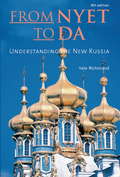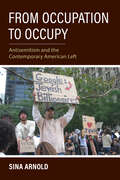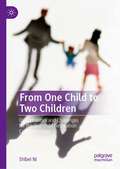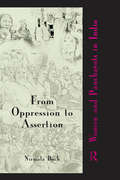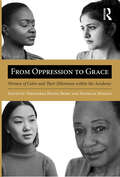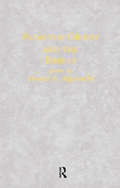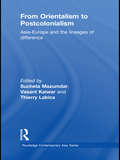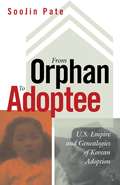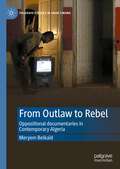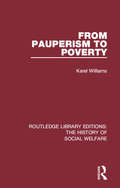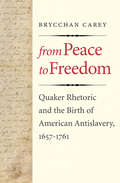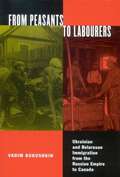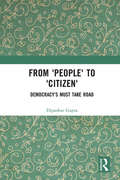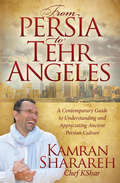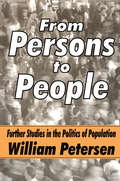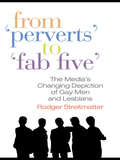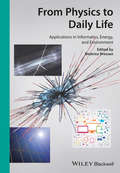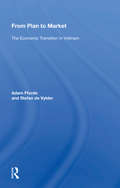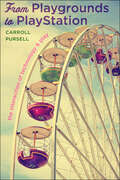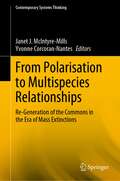- Table View
- List View
From Nyet to Da: Understanding the New Russia (Interact Ser.)
by Yale RichmondIn the wake of the Cold War and perestroika, the New Russia is finding its place in the global world. No longer a superpower, but still a nation with great influence, Russia remains an enigmatic and mysterious land. Like earlier editions, the new fourth edition of From Nyet to Da illuminates the dynamics of traditional Russian culture in the framework of contemporary events, such as the March 2008 elections and the Georgian conflict. With a new preface, and updates and revisions throughout, From Nyet to Da enlightens readers about virtually every aspect of Russian life, covering social and interpersonal skills as well as the underlying cultural assumptions and values of the Russian people.
From Occupation to Occupy: Antisemitism and the Contemporary American Left (Studies in Antisemitism)
by Sina ArnoldThe recent rise of antisemitism in the United States has been well documented and linked to groups and ideologies associated with the far right. In From Occupation to Occupy, Sina Arnold argues that antisemitism can also be found as an "invisible prejudice" on the left. Based on participation in left-wing events and demonstrations, interviews with activists, and analysis of left-wing social movement literature, Arnold argues that a pattern for enabling antisemitism exists. Although open antisemitism on the left is very rare, there are recurring instances of "antisemitic trivialization," in which antisemitism is not perceived as a relevant issue in its own right, leading to a lack of empathy for Jewish concerns and grievances. Arnold's research also reveals a pervasive defensiveness against accusations of antisemitism in left-wing politics, with activists fiercely dismissing the possibility of prejudice against Jews within their movements and invariably shifting discussions to critiques of Israel or other forms of racism. From Occupation to Occupy offers potential remedies for this situation and suggests that a progressive political movement that takes antisemitism seriously can be a powerful force for change in the United States.
From One Child to Two Children: Opportunities and Challenges for the One-child Generation Cohort in China
by Shibei NiThis book dissects the reproductive intentions and behaviours of the one-child generation cohort in China, situated in the wider context of changing family life patterns and gendered lenses. Demonstrating that the one-child family is still favoured by the one-child generation, this book uncovers the socioeconomic dimensions and mechanisms of family relations underlying young people’s decision-making processes. It also incorporates individual considerations and experiences of childbearing from over 50 interviews to contribute to the development of China's social policy. Whereas men’s childbearing beliefs were relatively unexplored in the literature, the author included male interviewees to better reflect gender differences in relation to childbearing, employment and family. Analysing the relationship between life routine and the desire (or lack thereof) to increase China's population, the author argues that the current childbearing policy fails to accommodate the needs and demands of young people, thus limiting the uptake of China’s new policy.
From Oppression to Assertion: Women and Panchayats in India
by Nirmala BuchThe book explores the experiences, impact and responses of women in village panchayats in India after a Constitutional Amendment in 1992 made it mandatory to reserve one-third positions for women. Based on extensive field research with interviews of 1,200 panchayat representatives and community members in Madhya Pradesh, Rajasthan and Uttar Pradesh (states usually seen as low on social and gender indicators), the book documents awareness, motivation, perceptions, and participation levels of women elected in the first election following the Amendment, with a follow-up survey of the same panchayats in the next two elections. This work maps the empowering impact on women’s self, the attitudes and perceptions of the family and responses of other social institutions. It explodes the myth of women’s disinterest in politics, the entry of only affluent women and relatives of influential politicians, and particularly, of these women as proxy for their male kin. The recent policy announcements reserving more seats for women in panchayats (from one-third to one-half) makes this book topical, and especially interesting in light of the opposition to the reservation of seats for women in state legislatures and the parliament.
From Oppression to Grace: Women of Color and Their Dilemmas within the Academy
by Theodorea Regina Berry Nathalie D. MizelleThis book gives voice to the experiences of women of color--women of African, Native American, Latina, East Indian, Korean and Japanese descent--as students pursuing terminal degrees and as faculty members navigating the Academy, grappling with the dilemmas encountered by others and themselves as they exist at the intersections of their work and identities.Women of color are frequently relegated--on account both of race and womanhood--into monolithic categories that perpetuate oppression, subdue and suppress conflict, and silence voices. This book uses critical race feminism (CRF) to place women of color in the center, rather than the margins, of the discussion, theorizing, research and praxis of their lives as they co-exist in the dominant culture. The first part of the book addresses the issues faced on the way to achieving a terminal degree: the struggles encountered and the lessons learned along the way. Part Two, "Pride and Prejudice: Finding Your Place After the Degree" describes the complexity of lives of women with multiple identities as scholars with family, friends, and lives at home and at work. The book concludes with the voices of senior faculty sharing their journeys and their paths to growth as scholars and individuals.This book is for all women of color growing up in the academy, learning to stand on their own, taking first steps, mastering the language, walking, running, falling and getting up to run again--and illuminates the process of self-definition that is essential to their growth as scholars and individuals.
From The Orient & The Desert: Poems
by Ghazi A. AlgosaibiFirst Published in 1994. From the Orient and the Desert is a collection of fifteen poems from Ghazi A. Algosaibi. With pencil drawn illustrations by Andrew Vicari.
From Orientalism to Postcolonialism: Asia, Europe and the Lineages of Difference (Routledge Contemporary Asia Series)
by Sucheta MazumdarThis book uses a historical and theoretical focus to examine the key of issues of the Enlightenment, Orientalism, concepts of identity and difference, and the contours of different modernities in relation to both local and global shaping forces, including the spread of capitalism. The contributors present eight in-depth studies and a substantial theoretical introduction, utilizing primary and secondary sources in Turkish, Farsi, Chinese, not to mention English, French and German in the effort to engage materials and cultural perspectives from diverse regions. It provides a critical attempt to think through the potentialities and limitations of area-studies and ‘civilizational’ approaches to the production of knowledge about the modern world, and the often obscured relationship between the fragment and the whole, or the particular and universal. The book is an intervention in one of the most fundamental debates confronting the social science and humanities, namely how to understand global and local historical processes as interconnected developments affecting human actors. From Orientalism to Postcolonialism will be of interest to academics and postgraduate students in Cultural and Postcolonial Studies and Asian studies and Middle Eastern studies.
From Orphan to Adoptee: U.S. Empire and Genealogies of Korean Adoption (Difference Incorporated)
by SooJin PateSince the 1950s, more than 100,000 Korean children have been adopted by predominantly white Americans; they were orphans of the Korean War, or so the story went. But begin the story earlier, as SooJin Pate does, and what has long been viewed as humanitarian rescue reveals itself as an exercise in expanding American empire during the Cold War.Transnational adoption was virtually nonexistent in Korea until U.S. military intervention in the 1940s. Currently it generates $35 million in revenue—an economic miracle for South Korea and a social and political boon for the United States. Rather than focusing on the families &“made whole&” by these adoptions, this book identifies U.S. militarism as the condition by which displaced babies became orphans, some of whom were groomed into desirable adoptees, normalized for American audiences, and detached from their past and culture.Using archival research, film, and literary materials—including the cultural work of adoptees—Pate explores the various ways in which Korean children were employed by the U.S. nation-state to promote the myth of American exceptionalism, to expand U.S. empire during the burgeoning Cold War, and to solidify notions of the American family. In From Orphan to Adoptee we finally see how Korean adoption became the crucible in which technologies of the U.S. empire were invented and honed.
From Outlaw to Rebel: Oppositional documentaries in Contemporary Algeria (Palgrave Studies in Arab Cinema)
by Meryem BelkaïdThis book analyzes the rise of socially and politically engaged Algerian documentaries, created in the period immediately following the end of the Algerian civil war (1991-1999). It uses case studies to highlight the works of four Algerian filmmakers, and devotes a chapter to each: Malek Bensmaïl, Hassen Ferhani, Djamel Kerkar, and Karim Sayad. The book makes visible productions that have been overlooked not only in distribution circuits but also within academia, and examines the political significance and the esthetic power of some of the most influential Algerian documentaries produced since the 2000s.
From Parents to Children: The Intergenerational Transmission of Advantage
by John Ermisch Markus Jantti Timothy M. SmeedingDoes economic inequality in one generation lead to inequality of opportunity in the next? In From Parents to Children, an esteemed international group of scholars investigates this question using data from ten countries with differing levels of inequality. The book compares whether and how parents' resources transmit advantage to their children at different stages of development and sheds light on the structural differences among countries that may influence intergenerational mobility. How and why is economic mobility higher in some countries than in others? The contributors find that inequality in mobility-relevant skills emerges early in childhood in all of the countries studied. Bruce Bradbury and his coauthors focus on learning readiness among young children and show that as early as age five, large disparities in cognitive and other mobility-relevant skills develop between low- and high-income kids, particularly in the United States and the United Kingdom. Such disparities may be mitigated by investments in early childhood education, as Christelle Dumas and Arnaud Lefranc demonstrate. They find that universal pre-school education in France lessens the negative effect of low parental SES and gives low-income children a greater shot at social mobility. Katherine Magnuson, Jane Waldfogel, and Elizabeth Washbrook find that income-based gaps in cognitive achievement in the United States and the United Kingdom widen as children reach adolescence. Robert Haveman and his coauthors show that the effect of parental income on test scores increases as children age; and in both the United States and Canada, having parents with a higher income betters the chances that a child will enroll in college. As economic inequality in the United States continues to rise, the national policy conversation will not only need to address the devastating effects of rising inequality in this generation but also the potential consequences of the decline in mobility from one generation to the next. Drawing on unparalleled international datasets, From Parents to Children provides an important first step.
From Pauperism to Poverty (Routledge Library Editions: The History of Social Welfare #24)
by Karel WilliamsFirst published in 1981, From Pauperism to Poverty consists of seven essays, three of which focus on the English poor law between 1800 and 1914 and four of which examine texts of social investigation by Mayhew, Engels, Booth and Rowntree. Rather than making a specialist contribution to the history of social thought and policy, the essays raise general questions about current ways of writing history and alternative analyses of specific texts or institutions are developed. In doing so, the previous histories of the relief of pauperism and the discovery of poverty are revised at many points. Most notably, it is demonstrated for the first time that relief to unemployed men was virtually abolished after 1850. This book will be of interest to those studying the history of social welfare and poverty.
From Peace to Freedom
by Brycchan CareyIn the first book to investigate in detail the origins of antislavery thought and rhetoric within the Society of Friends, Brycchan Carey shows how the Quakers turned against slavery in the first half of the eighteenth century and became the first organization to take a stand against the slave trade. Through meticulous examination of the earliest writings of the Friends, including journals and letters, Carey reveals the society’s gradual transition from expressing doubt about slavery to adamant opposition. He shows that while progression toward this stance was ongoing, it was slow and uneven and that it was vigorous internal debate and discussion that ultimately led to a call for abolition. His book will be a major contribution to the history of the rhetoric of antislavery and the development of antislavery thought as explicated in early Quaker writing.
From Peasants to Labourers
by Vadim KukushkinWritten from the migration systems perspective, From Peasants to Labourers places the migration of Ukrainian and Belarusan peasant-workers within the context of Old- and New-World economic structures and state policies. Through painstaking analysis of thousands of personal migrant files in the archives of the Russian consulates in Canada, Kukushkin fills a void in our knowledge of the geographic origins, spatial trajectories, and ethnic composition of early twentieth-century Canadian immigration from Eastern Europe. From Peasants to Labourers also provides important insights into the nature of ethnic identity formation through an exploration of the meaning of "Russianness" in early twentieth-century Canada.
From Peasants to Labourers: Ukrainian and Belarusan Immigration from the Russian Empire to Canada (McGill-Queen's Studies in Ethnic History #23)
by Vadim KukushkinWritten from the migration systems perspective, From Peasants to Labourers places the migration of Ukrainian and Belarusan peasant-workers within the context of Old- and New-World economic structures and state policies. Through painstaking analysis of thousands of personal migrant files in the archives of the Russian consulates in Canada, Kukushkin fills a void in our knowledge of the geographic origins, spatial trajectories, and ethnic composition of early twentieth-century Canadian immigration from Eastern Europe. From Peasants to Labourers also provides important insights into the nature of ethnic identity formation through an exploration of the meaning of "Russianness" in early twentieth-century Canada.
From 'People' to 'Citizen': Democracy’s Must Take Road
by Dipankar GuptaFrom ‘People’ to ‘Citizen’ brings together social theory with policy practice to enlarge our understanding of the difference that democracy makes to the life of a nation. Unlike nationalism, democracy takes our attention away from the past to the future by focusing on the specific concerns of ‘citizenship’. Historical victories or defeats, blood and soil are now nowhere as relevant as the creation of a foundational base where individuals have equal, and quality, access to health, education, and even urban services. The primary consideration, therefore, is on empowering ‘citizens’ as a common category and not ‘people’ of any specific community or class. When citizens precede all other considerations, the notion of the ‘public’ too gets its fullest expression. Differences between citizens are not denied, in fact encouraged, but only after achieving a basic unity first. This book argues that the call of citizenship not only advances democracy, but social science as well. Please note: Taylor & Francis does not sell or distribute the Hardback in India, Pakistan, Nepal, Bhutan, Bangladesh and Sri Lanka
From Persia to Tehr Angeles: A Contemporary Guide to Understanding and Appreciating Ancient Persian Culture
by Kamran Sharareh Chef KSharAn Iranian-American explains the history and heritage of his people, in both the old world and the new. From Persia to Tehr Angeles is a fascinating look at everything from Persia&’s ancient past to the modern world of Persian-American immigrants in places like Los Angeles—offering a rich, rounded view a culture many are unfamiliar with. For those who are part of this history, their friends and families, or anyone interested in this corner of the world, it&’s an enlightening look at traditions, food, religion, and other aspects of this complex society over many generations.
From Persons to People: A Second Primer in Demography
by William PetersenProblems associated with aggregation and classification are the underlying theme of this book. When data assembled from individuals are presented as group characteristics, this process has logical complications. Racial profiling and ethnic discrimination are obvious examples of the problem. Petersen's book analyzes in general how information from "persons" turns into statistics about specific "people." The book is divided into two parts covering population and ethnicity. The first two chapters in part 1, on population statistics and the age-sex structure, are the foundations for any demographic analysis. Chapter 3 is a brief review of the interminable debate over whether the subsistence of mankind is on the point of depletion. The three following chapters are on population theory as expounded by Malthus, Marx, and Communists. Chapters 7 and 8 discuss the competition between parents and the state concerning which of the two shall decide on procreation. Chapter 9 is an account of population at the frontier, using Nevada as a prototype. The last chapter in part 1 is a proposal, to moderate the endless debate about abortion. The first two chapters in the second part of the book concern methods for analyzing ethnicity that are essential for a full understanding of demography: how and by whom ethnic groups are defined. The next chapter discusses some of the many subdivisions of European nations, countering the analyses of European unity with the fact that most of its regions are not themselves homogeneous. In a number of instances American statistical agencies have used surnames to identify nationalities, with invalid results, as the author shows in the next chapter. "Jews as a Race" is an attempt to counter Nazi dogma with a rational analysis of a contentious topic. The subsequent chapters compare Japanese and Chinese Americans as small but fascinating minorities and analyze the social consequences of religion from theoretical and factual viewpoints. The last chapter summarizes the conclusions to be drawn from these topics. Demographers, sociologists, and statisticians, as well as those generally concerned with social policy, will find From Persons to People useful and courageous-the hallmark of the dean of sociological demography. .
From Perverts to Fab Five: The Media's Changing Depiction of Gay Men and Lesbians
by Rodger StreitmatterFrom "Perverts" to "Fab Five" tracks the dramatic change in how the American media have depicted gay people over the last half-century. Each chapter illuminates a particular media product that served as a milestone on the media's journey from demonizing homosexuals some fifty years ago to celebrating gay people--or at least some categories of gay people--today. The media, Streitmatter argues, have not merely reflected the American public's shift to a more enlightened view of gay people, but they have been instrumental in propelling that change. The book spans the breadth of communication venues. Individual chapters focus on major news stories, entertainment television programs, and mainstream motion pictures that captured the public imagination while, at the same time, sending powerful messages about gay men and lesbians. Ideal for any reader interested in the changing depiction of gay men and lesbians in the media over time, or as required reading in media courses.
From Physics to Daily Life
by Beatrice BressanBeatrice Bressan brings together a number of outstanding examples of successful cross-disciplinary technology transfer originating in fundamental physics research, which dramatically impacted scientific progress in areas which changed modern society. Many of them were developed at CERN, a hotbed of fundamental inventions in particle physics. This book deals with breakthrough developments being applied in the world of IT, consumer electronics, aviation, and material sciences.Additional sections of the book deal with knowledge management and technology transfer including their economic aspects. While each chapter has been drafted by an expert in the field, the editor has carefully edited the whole to ensure a coherent overall structure.A must-have for policy makers, technology companies, investors, strategic planners in research and technology, as well as attractive reading for the research community.
From Physics to Daily Life: Applications in Informatics, Energy, and Environment
by Beatrice BressanBeatrice Bressan brings together a number of outstanding examples of successful cross-disciplinary technology transfer originating in fundamental physics research, which dramatically impacted scientific progress in areas which changed modern society. Many of them were developed at CERN, a hotbed of fundamental inventions in particle physics. This book deals with breakthrough developments being applied in the world of IT, consumer electronics, aviation, and material sciences. Additional sections of the book deal with knowledge management and technology transfer including their economic aspects. While each chapter has been drafted by an expert in the field, the editor has carefully edited the whole to ensure a coherent overall structure. A must-have for policy makers, technology companies, investors, strategic planners in research and technology, as well as attractive reading for the research community.
From Pigeons to News Portals: Foreign Reporting and the Challenge of New Technology (Media & Public Affairs)
by David D. Perlmutter John Maxwell HamiltonEver since the invention of the telegraph, journalists have sought to remove the barriers of time and space. Today, we readily accept that reporters can jet quickly to a distant location and broadcast instantly from a satellite-connected, video-enabled cell phone hanging from their belts. But now that live news coverage is possible from virtually anywhere, is foreign correspondence better? And what are the implications of recent changes in journalistic technology for policy makers and their constituents? In From Pigeons to News Portals, edited by David D. Perlmutter and John Maxwell Hamilton, scholars and journalists survey, probe, and demystify the new foreign correspondence that has emerged from rapidly changing media technology. These distinguished authors challenge long-held beliefs about foreign news coverage, not the least of which is whether, in our interconnected world, such a thing as "foreign news" even exists anymore. Essays explore the ways people have used new media technology -- from satellites and cell phones to the Internet -- to affect content, delivery modes, and amount and style of coverage. They examine the ways in which speedy reporting conflicts with in-depth reporting, the pros and cons of "parachute" journalism, the declining dominance of mainstream media as a source of foreign news, and the implications of this new foreign correspondence for foreign policy. Entertainment media such as film, television, and video gaming form worldwide opinions about America, often in negative ways. Meanwhile, live reporting abroad is both a blessing and curse for foreign policy makers. Because foreign news is so vital to effective policy making and citizenship, we imperil our future by failing to understand the changes technology brings and how we can wrest the best practice out of those changes. This provocative volume offers valuable insights and analyses to help us better understand the evolving state of foreign news.
From Plan To Market: The Economic Transition In Vietnam
by Adam FfordeThis clear and accessible text explores Vietnam's successful transition from neo-Stalinist central planning to a market economy—\"Vietnamese style.\" After describing the north Vietnamese system prior to 1975 and its colonial and precolonial antecedents, the authors uncover the mechanisms of that changeover. They contend that the Vietnamese transition was largely bottom-up in character and that it evolved over a long enough period for the country's political economy to adjust. This explains in part the rapid shift to a high-growth, externally oriented development path in the early 1990s, despite the loss of Soviet aid and the lack of significant Western substitutes until 1992-1993. Based upon extensive incountry experience, a wealth of primary materials, and wide comparative knowledge of development issues, the book challenges many preconceived notions, both about Vietnam and about the general nature of transition processes.
From Playgrounds to PlayStation: The Interaction of Technology and Play
by Carroll PursellHow technology shapes play in America—and vice versa.In this romp through the changing landscape of nineteenth- and twentieth-century American toys, games, hobbies, and amusements, senior historian of technology Carroll Pursell poses a simple but interesting question: What can we learn by studying the relationship between technology and play? From Playgrounds to PlayStation explores how play reflects and drives the evolution of American culture. Pursell engagingly examines the ways in which technology affects play and play shapes people. The objects that children (and adults) play with and play on, along with their games and the hobbies they pursue, can reinforce but also challenge gender roles and cultural norms. Inventors—who often talk about "playing" at their work, as if motivated by the pure fun of invention—have used new materials and technologies to reshape sports and gameplay, sometimes even crafting new, extreme forms of recreation, but always responding to popular demand.Drawing from a range of sources, including scholarly monographs, patent records, newspapers, and popular and technical journals, the book covers numerous modes and sites of play. Pursell touches on the safety-conscious playground reform movement, the dazzling mechanical innovations that gave rise to commercial amusement parks, and the media's colorful promotion of toys, pastimes, and sporting events. Along the way, he shows readers how technology enables the forms, equipment, and devices of play to evolve constantly, both reflecting consumer choices and driving innovators and manufacturers to promote toys that involve entirely new kinds of play—from LEGOs and skateboards to beading kits and videogames.
From Playgrounds to Playstation: The Interaction of Technology & Play
by Carroll PursellThis “engaging social history of play” explores how technology and culture have shaped toys, games, and leisure—and vice versa (Choice).In this romp through the changing landscape of nineteenth- and twentieth-century American toys, games, hobbies, and amusements, technology historian Carroll Pursell poses a simple but interesting question: What can we learn by studying the relationship between technology and play?From Playgrounds to PlayStation explores how play reflects and drives the evolution of American culture. Pursell engagingly examines the ways in which technology affects play and play shapes people. The objects that children (and adults) play with and play on, along with their games and the hobbies they pursue, can reinforce but also challenge gender roles and cultural norms. Inventors—who often talk about “playing” at their work, as if motivated by the pure fun of invention—have used new materials and technologies to reshape sports and gameplay, sometimes even crafting new, extreme forms of recreation, but always responding to popular demand.Drawing from a range of sources, including scholarly monographs, patent records, newspapers, and popular and technical journals, the book covers numerous modes and sites of play. Pursell touches on the safety-conscious playground reform movement, the dazzling mechanical innovations that gave rise to commercial amusement parks, and the media’s colorful promotion of toys, pastimes, and sporting events. Along the way, he shows readers how technology enables the forms, equipment, and devices of play to evolve constantly, both reflecting consumer choices and driving innovators and manufacturers to promote toys that involve entirely new kinds of play—from LEGOs and skateboards to beading kits and videogames.
From Polarisation to Multispecies Relationships: Re-Generation of the Commons in the Era of Mass Extinctions (Contemporary Systems Thinking)
by Yvonne Corcoran-Nantes Janet J. McIntyre-MillsThis book explores the concept of multi-species relationships and suggests critical systemic pathways to protect shared habitats. This book discusses how the eradication of species as a result of rapid urbanisation places humanity at risk. This book demonstrates how narrow anthropocentrism has focused on the rights of human beings at the expense of other species and the environment. This book explores a priori norms and a posteriori measures and indicators to include and protect multiple species. This book aims to strengthen institutional capacity and powers to address and extend the UN 2030 Sustainable Development Agenda by drawing on local wisdom but also the need to implement laws to prevent ecocide. This book highlights that our fragile interdependence requires a recognition of our hybridity and interconnectedness within the web of life and suggests ways to reframe policy within and beyond the nation state to support living systems of which we are a strand.
